Hippo Profile
The hippopotamus, or hippo, is native to sub-Saharan Africa and is a large, mostly herbivorous mammal.
The name hippopotamus comes from an ancient Greek word that translates to mean ‘river horse’ and the hippo is the third-largest land mammal following the elephant and rhinoceros.
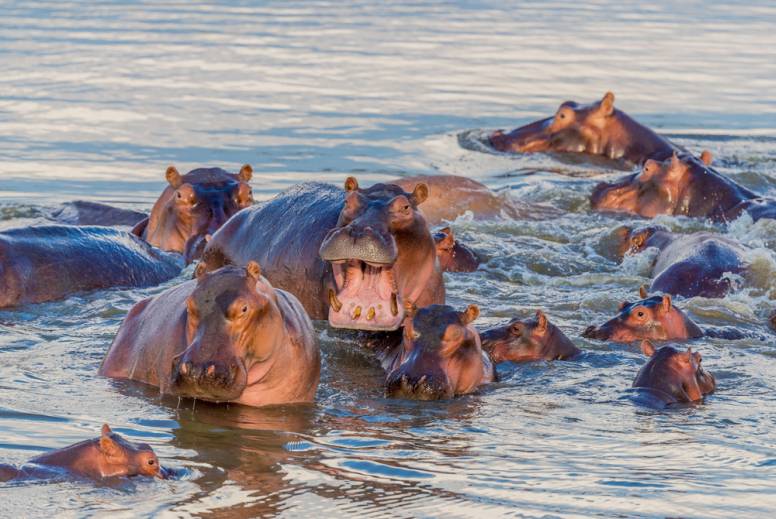
Hippo Facts Overview
| Habitat: | Rivers, lakes & mangrove swamps |
| Location: | sub-Saharan Africa, Colombia |
| Lifespan: | 40 – 50 years |
| Size: | 13 – 18 ft (4 to 5.5 m) |
| Weight: | 1,760 – 3,530 pounds (800 – 1,600 kg) |
| Color: | Grey, black, brownish purple |
| Diet: | Herbivore – Grass & fruit |
| Predators: | Crocodiles, lions & hyenas can prey on baby hippo. Adults, don’t generally have predators. |
| Top Speed: | 40 Kph (30 mph) |
| No. of Species: | 2 |
| Conservation Status: | Vulnerable |
The hippo can be found in lakes, rivers and mangrove swamps. Male hippos are known as ‘bulls‘, female hippos are ‘cows‘, and babies are ‘calves‘.
Territorial males will control a pre-determined stretch of water, which will include a group of five to thirty females and their young. This group of hippos is actually known as a ‘bloat‘.
The main reason why hippos are often found near bodies of water is that this is how they stay cool and prevent sunburn. During the hot daytime a hippo will either stay in water or mud in order to cool down.
Hippos may be seen near each other at rest, but feeding is done in solo and they are not territorial on land. The hippo generally grazes after dusk when it is cooler.
They are characterized by their barrel-shaped torsos. The hippo mouth is wide and open which contains large canine tusks. They have bodies that contain little hair, short columnar legs and can weigh up to 4,400 pounds for males and females are slightly smaller at 2,800-pounds.
There are two species of hippo, the modern hippopotamus and the pygmy hippopotamus, which is native to the forests and swamps of West Africa, primarily in Liberia.
The female hippo has a gestation period of eight months. Baby hippos are born underwater and will weigh between 55 and 100-pounds and will be about 4-feet long. They must swim to the surface in order to take their first breath of air. A normal birth rate is a single calf, but twins are not uncommon.
Mothers are very protective of their young and calves are often left together in ‘nurseries’ which are usually watched by one or more adults. While in these nurseries, the baby hippos will engage in play fights which prepare them for when they must fend for themselves.
While the hippo used to be found all over the sub-Saharan area of Africa, their modern habitat is much smaller – barely a fraction of the size! This loss of habitat is one reason why they’re now considered a vulnerable species.
Interesting Hippo Facts
1. Hippos are the deadliest large land animal on the planet
The Hippopotamus is one of the most dangerous animals in the world, killing an estimated 500 people a year in Africa.
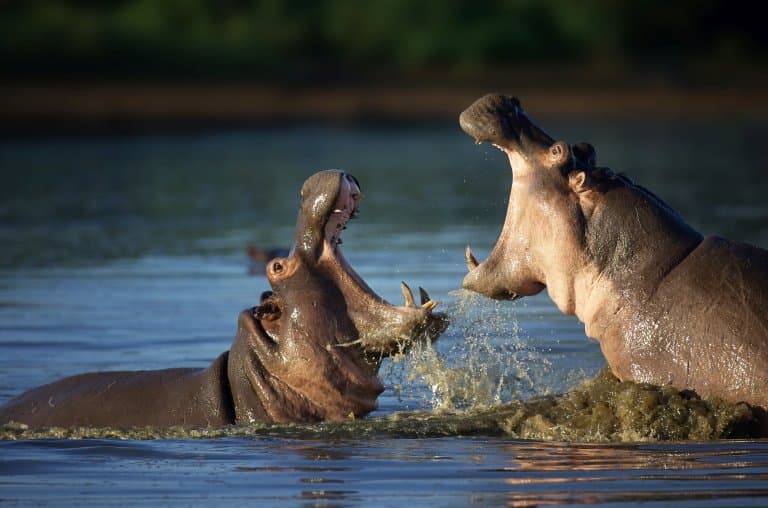
They are extremely aggressive, unpredictable, have sharp teeth and can crush a human or predator to death with relative ease due to their size.
In one 2014 case in Niger, a boat was capsized by a hippo and 13 people were killed. 1
2. Hippos love the water!
The hippopotamus is a semi-aquatic mammal. This means that even though they’re a mammal like humans, dogs, cats, and other similar species, they spend a majority of their life in the water. Their historic habitat even included the Nile River.
They love the water so much that the Greeks had named them river horses!
However, they only spend their days in the water. By night, they’re on the land and grazing for up to 6 hours.
3. There’s only one wild herd famous outside of Africa…
And it has its roots entangled with Pablo Escobar!
During his time, Escobar ran a private zoo which featured hippopotamuses. After he left, however, they escaped into the wild and continued to thrive in Colombia, where they are now part of a herd of at least 80.
Since the hippo is an invasive species in this area that could damage the river ecosystems and native wildlife, there are now efforts to help reduce their ability to reproduce, providing a more humane way to halt the growth of the herd. 2
4. The hippo is a victim of ivory poaching
When you think about poaching and ivory, you probably think about rhinos and elephants. However, the hippopotamus is also a victim of this crime, which is another reason aside from habitat loss that they’re endangered.
While they may not have tusks or horns, the hippo’s front teeth are made of ivory. This ivory is harder than an elephants, making it more durable but more difficult to carve.
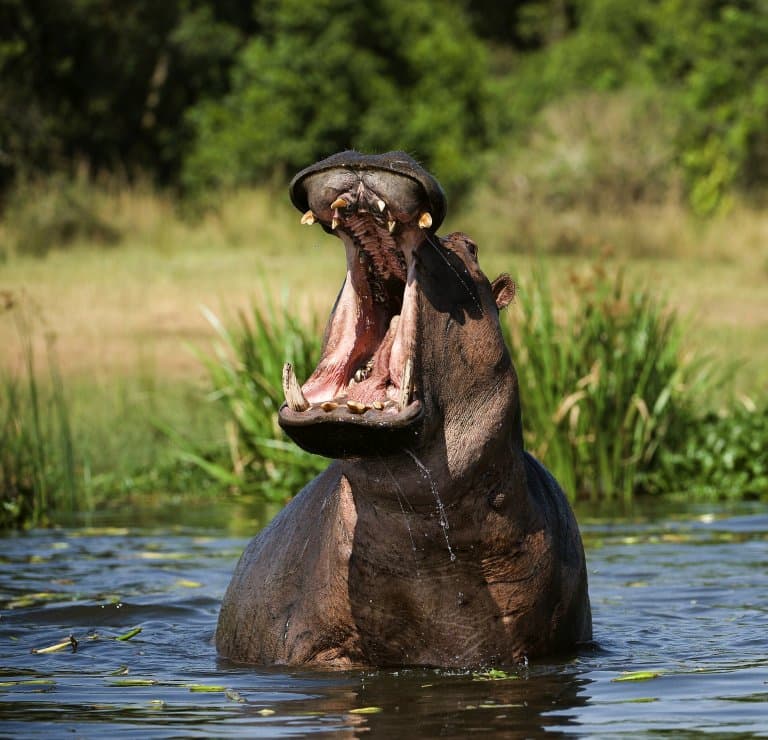
The incisors can reach 40 cm (1 ft 4 in), while the canines reach up to 50 cm (1 ft 8 in). 3
5. They can eat around 35 kg of grass in a single night…every night!
Ever heard the saying “hungry as a hippo”? There’s more truth to that than meets the eye!
During the night, when hippos return to land, they spend up to six hours grazing on grass and any fallen fruit they might stumble across. In a single night, a single hippopotamus can easily eat 35 kilograms of grass!

Not sure just how impressive that is? Some other things that weigh around 35 kilograms are a small sofa, a chest freezer, a single twin bed (frame and mattress included), and medium size dryer.
Imagine eating an entire dryer’s worth of weight in your favorite food every day!
6. Hippos can open their mouths at almost 180 degrees
Hippos can open their mouths over 50cms wide, and their jaw hinge is located far back, allowing them to open at almost 180 degrees.
Hippopotamus bite force measures 12 600 kPa. By comparison, a lion’s bite force is only 4500 kPa.
The hippopotamus, with his ferocious jaw force, unique mouth size and sharp teeth, can easily bisect a human body in a single bite! 4
7. They can reach top speeds over 40 kph
At a first glance, you may think that the hippopotamus is one of the slowest animals around. After all, they have odd proportions and weigh a ton (literally).
However, while they’re not the fastest animal by far, the hippopotamus can reach top speeds over 40 kph when they’re running on land. This is around the same speed as a moped!
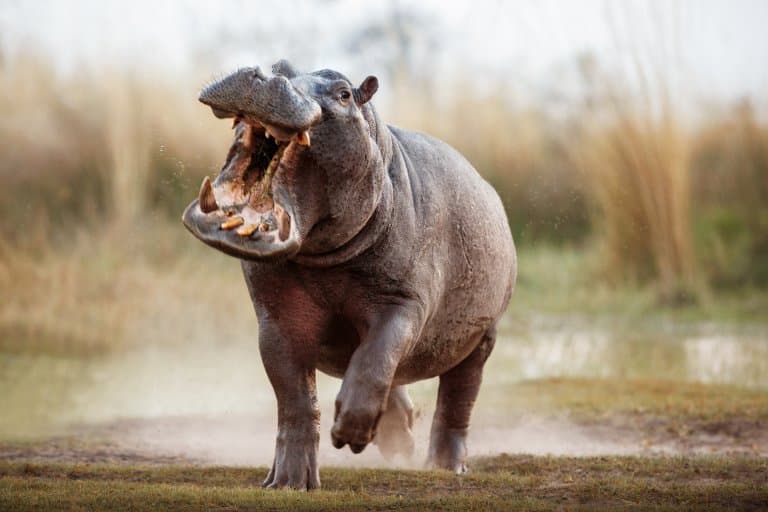
As a result, a human has no hope of out running one of these massive mammals. That’s one reason why hippos kill more humans in Africa each year than any other species, including big cats.
8. Predators are only really a threat when a hippo is alone
Taking a quick look out our hippopotamus profile, you’ll notice that these mostly water dwellers have quite a few predators both in the water and on land. From big cats to hyenas to crocodiles, there are many animals that pose a threat to the hippopotamus.
However, only when they’re alone.
There’s a reason that hippos travel in dense herds. While they’re easy targets alone, an entire herd of hippopotamuses can easily throw their weight around.
With the strongest bite strength of all land animals and a knack for aggression, the hippopotamus can easily defend itself so long as its not out numbered. They’ve even been known to chase down human boats!
9. Hippos can’t swim
The most surprising fact of them all? Hippos can’t swim!
That’s right, despite how much they love the water and having webbed feet, hippos aren’t actually the best swimmers. They aren’t even swimmers at all! Instead, they have such a high body density that they sink right to the bottom of the river where, instead of swimming, they gallop through the water.
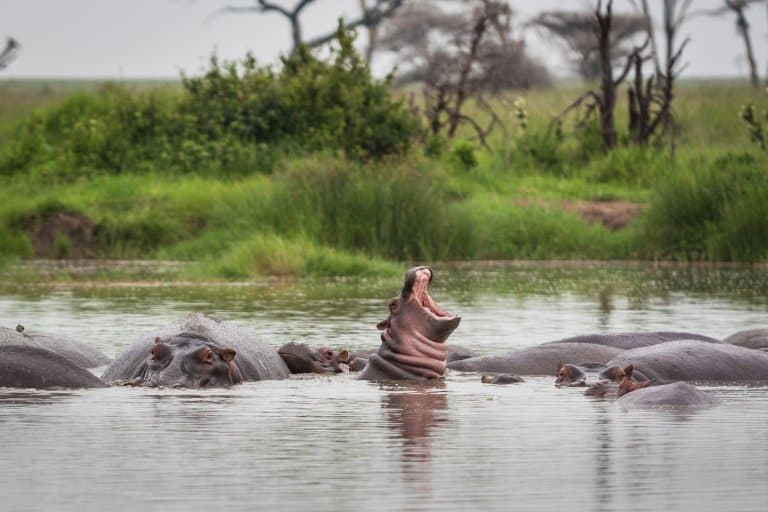
Turns out they earned the name “river horse” for many reasons! Fortunately hipppos can hold their breath for up to 5 minutes.
10. They weigh as much as a car
Adult male hippos can weigh about 3,300-pounds with females reaching 2,800-pounds. Very large males can grow to 4,400-pounds with exceptional large ones reaching 5,800-pounds.
11. A Hippo can live to become a senior citizen
The average lifespan of a hippopotamus is between 40 and 50 years.
However, the oldest living hippo in captivity set a record when she died in 2017. Bertha was a resident of the Manila Zoo in the Phillipines. At the time of her death she was 65.
12. Hippos can be traced back about 52-million years ago
A total of six species of Hippopotamus are extinct with three of them being subspecies of the Malagasy Hippopotamus.
These species were much smaller in size than the modern hippo with the last of them disappearing in the past century.
There are also three species of the European Hippopotamus that have become extinct.
13. Hippos engage in ‘muck-spreading’
This involves marking territory with their own faeces – by spinning their tail which acts as a fan to spread their faeces over a greater area!
Gross!
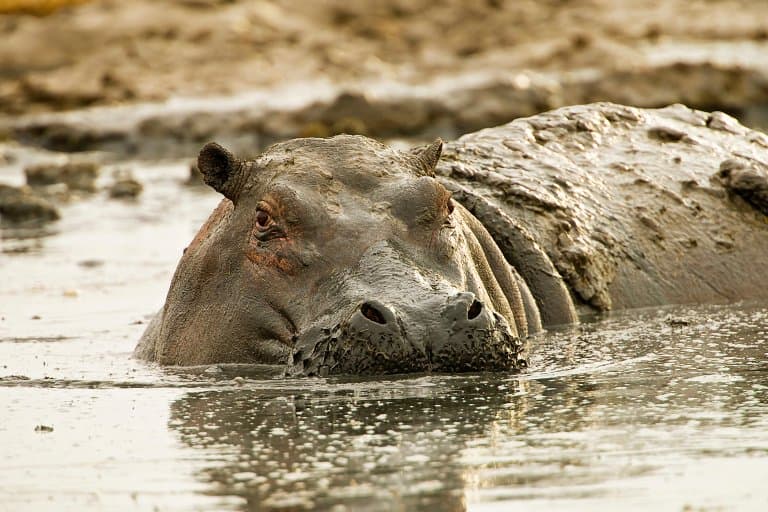
14. They can sleep underwater
Hippos are able to sleep while fully submerged underwater, intermittently surfacing to the surfce using a reflex that allows them to take a breath, before sinking back down – without waking up!
When completely submerged, their ears and nostrils fold shut to keep water out.
15. The IUCN lists hippos as vulnerable
Hippos are thought to have a stable population estimated between 115,000 and 130,000 animals.
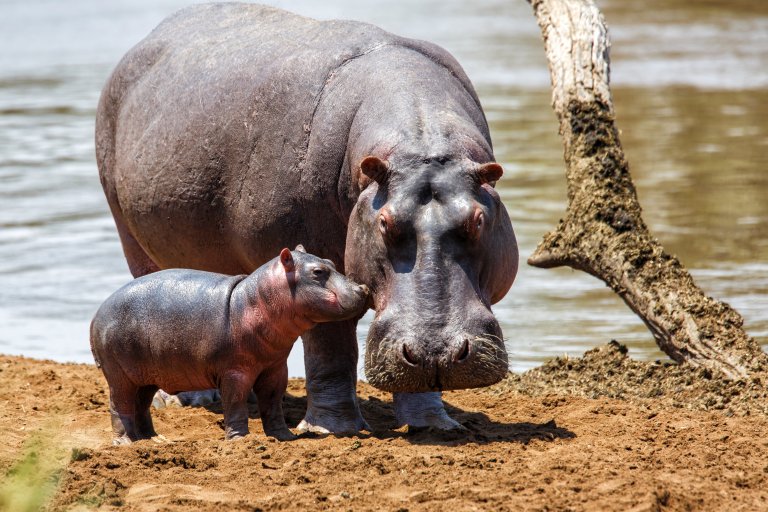
Sadly however, hippos are considered vulnerable due to loss of access to fresh water and being subject to poaching.
Hippo Fact-File Summary
Scientific Classification
| Kingdom: | Animalia |
| Phylum: | Chordata |
| Class: | Mammalia |
| Order: | Artiodactyla |
| Family: | Hippopotamidae |
| Genus: | Hippopotamus |
| Species Name: | H. amphibius |
Fact Sources & References
- AFP. “Hippopotamus attack kills 13 people, including 12 children, in boat near Niger’s capital Niamey” ABC News. November 19, 2014.
- Weisburger, Mindy. “Pablo Escobar’s ‘cocaine hippos’ are being sterilized because the population is out of control.” Live Science. October 21, 2021.
- Berkovitz, Barry K.B. “Tusks and Ivory” in Nothing but a Tooth. 2013.
- Moustafa M Haddara et al. “Hippopotamus bite morbidity: a report of 11 cases from Burundi“. National Library of Medicine. August 10th, 2020.
